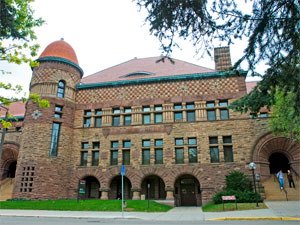Geology and Geophysics is now Earth Sciences

Department names new leadership
MINNEAPOLIS / ST. PAUL (07/01/2011)—To more accurately reflect the department’s current and future activities, the Department of Geology and Geophysics has changed its name to the Department of Earth Sciences. The change was approved by the University of Minnesota Board of Regents and takes effect July 1, 2011. The change comes on the heels of a name change for both the undergraduate and graduate majors.
The primary reason for changing the name is to more accurately reflect the department’s teaching and research activities that now include fields far beyond geology and geophysics. In the past several decades, the department has significantly broadened its scope to include important fields such as geochemistry, hydrogeology, and geobiology, as well as the original geology and geophysics.
Historically, the name Geology and Geophysics came about when the Department of Geology was transferred in 1962 to the Institute of Technology (now called the College of Science and Engineering) where it was joined with the Geophysics Unit from the School of Mines and Metallurgy. The name was one of convenience and compromise, reflecting the interests and backgrounds of faculty and students from the two programs.
Over the last several months, department faculty have extensively discussed and unanimously supported the name change. The department also worked closely with both undergraduate and graduate students throughout the process.
With input from undergraduate students, the department developed a new undergraduate curriculum to embrace the department’s expanded scope and the undergraduate major was renamed Earth Sciences. This modernized curriculum has focus areas in hydrogeology, geochemistry, environmental geology, and biogeosciences as well as the previous tracks in geology and geophysics.
Similarly, based on discussions with our graduate students, the department revised the graduate program by combining geology and geophysics into a single degree program. Graduate students receive either an M.S. or a Ph.D. in Earth Sciences with emphasis areas in geology, geophysics, hydrogeology, and/or geobiology.
This type of transformation is taking place across the country with the name Department of Geology quickly disappearing and Departments of Earth Sciences or, in some cases, Geosciences appearing in their place.
“Our faculty research addresses issues from earthquakes to carbon sequestration. We are convinced that changing our name to Department of Earth Sciences is a critical step in enhancing our national visibility, strengthening our position at the University, and representing ourselves more accurately to all constituents,” said long-time faculty member and acting department head Peter Hudleston.
New department leadership
Along with a new name, the department has new leadership. Professor Donna Whitney has been named as department head and head of the N.H. Winchell School of Earth Sciences effective July 1, 2012. While Whitney is on sabbatical during the 2011-12 academic year, former department head and longtime faculty member Peter Hudleston will serve as acting department head. Hudleston began his duties as acting head on July 1, 2011.
Whitney came to the University of Minnesota in 1997, starting as an assistant professor and was promoted to associate professor in 2000 and professor in 2005. Prior to coming to Minnesota, she was an assistant professor at the University of North Carolina, Chapel Hill for four years. Whitney has received numerous awards and honors, including being named a McKnight Land-Grant Professor in 1998 and a Distinguished McKnight University Professor in 2010. She was also elected as a fellow of the Geological Society of America in 2003 and a fellow of the Mineralogical Society of America in 2005. She also received an NSF CAREER Award in 1996.
Whitney’s research interests are focused on metamorphic geology and tectonics. Starting this fall, she will be directing a five-year, $3.5 million National Science Foundation project to study the recent tectonic evolution of Anatolia (Turkey). Her research has been published extensively and she is coauthor of books and textbooks. She teaches courses in Earth and its environments, geology and civilization, mineralogy, petrology, and more.
Whitney has a bachelor’s degree in geology from Smith College and a master’s and doctoral degree in geological sciences from the University of Washington.
